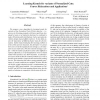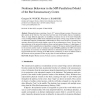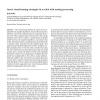2904 search results - page 70 / 581 » Number Forms in the Brain |
CVPR
2010
IEEE
13 years 9 months ago
2010
IEEE
We propose a new algorithm for learning kernels for variants of the Normalized Cuts (NCuts) objective – i.e., given a set of training examples with known partitions, how should ...
INFORMATICALT
2008
13 years 9 months ago
2008
Mammalian brains consisting of up to 1011 neurons belong to group of the most complex systems in the Universe. For years they have been one of the hardest objects of simulation. Th...
BC
2000
13 years 8 months ago
2000
Abstract The visual homing abilities of insects can be explained by the snapshot hypothesis. It asserts that an animal is guided to a previously visited location by comparing the c...
NN
2002
Springer
13 years 8 months ago
2002
Springer
Recognition-by-components is one of the possible strategies proposed for object recognition by the brain, but little is known about the low-level mechanism by which the parts of o...
ALIFE
2010
13 years 8 months ago
2010
Embodied artificial intelligence argues that the body and brain play equally important roles in the generation of adaptive behavior. An increasingly common approach therefore is to...



